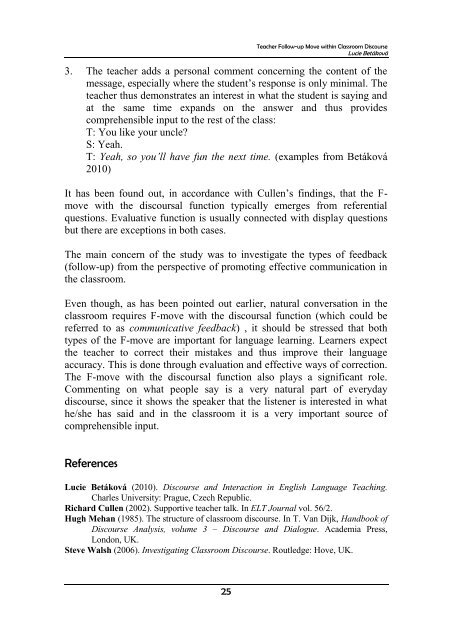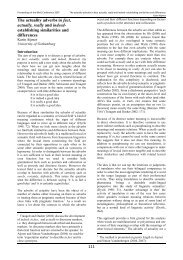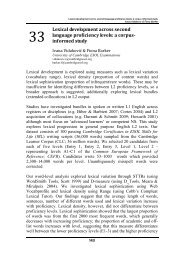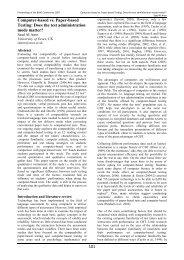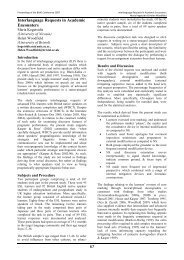Proceedings of the - British Association for Applied Linguistics
Proceedings of the - British Association for Applied Linguistics
Proceedings of the - British Association for Applied Linguistics
You also want an ePaper? Increase the reach of your titles
YUMPU automatically turns print PDFs into web optimized ePapers that Google loves.
25<br />
Teacher Follow-up Move within Classroom Discourse<br />
Lucie Betáková<br />
3. The teacher adds a personal comment concerning <strong>the</strong> content <strong>of</strong> <strong>the</strong><br />
message, especially where <strong>the</strong> student’s response is only minimal. The<br />
teacher thus demonstrates an interest in what <strong>the</strong> student is saying and<br />
at <strong>the</strong> same time expands on <strong>the</strong> answer and thus provides<br />
comprehensible input to <strong>the</strong> rest <strong>of</strong> <strong>the</strong> class:<br />
T: You like your uncle?<br />
S: Yeah.<br />
T: Yeah, so you’ll have fun <strong>the</strong> next time. (examples from Betáková<br />
2010)<br />
It has been found out, in accordance with Cullen’s findings, that <strong>the</strong> Fmove<br />
with <strong>the</strong> discoursal function typically emerges from referential<br />
questions. Evaluative function is usually connected with display questions<br />
but <strong>the</strong>re are exceptions in both cases.<br />
The main concern <strong>of</strong> <strong>the</strong> study was to investigate <strong>the</strong> types <strong>of</strong> feedback<br />
(follow-up) from <strong>the</strong> perspective <strong>of</strong> promoting effective communication in<br />
<strong>the</strong> classroom.<br />
Even though, as has been pointed out earlier, natural conversation in <strong>the</strong><br />
classroom requires F-move with <strong>the</strong> discoursal function (which could be<br />
referred to as communicative feedback) , it should be stressed that both<br />
types <strong>of</strong> <strong>the</strong> F-move are important <strong>for</strong> language learning. Learners expect<br />
<strong>the</strong> teacher to correct <strong>the</strong>ir mistakes and thus improve <strong>the</strong>ir language<br />
accuracy. This is done through evaluation and effective ways <strong>of</strong> correction.<br />
The F-move with <strong>the</strong> discoursal function also plays a significant role.<br />
Commenting on what people say is a very natural part <strong>of</strong> everyday<br />
discourse, since it shows <strong>the</strong> speaker that <strong>the</strong> listener is interested in what<br />
he/she has said and in <strong>the</strong> classroom it is a very important source <strong>of</strong><br />
comprehensible input.<br />
References<br />
Lucie Betáková (2010). Discourse and Interaction in English Language Teaching.<br />
Charles University: Prague, Czech Republic.<br />
Richard Cullen (2002). Supportive teacher talk. In ELT Journal vol. 56/2.<br />
Hugh Mehan (1985). The structure <strong>of</strong> classroom discourse. In T. Van Dijk, Handbook <strong>of</strong><br />
Discourse Analysis, volume 3 – Discourse and Dialogue. Academia Press,<br />
London, UK.<br />
Steve Walsh (2006). Investigating Classroom Discourse. Routledge: Hove, UK.


